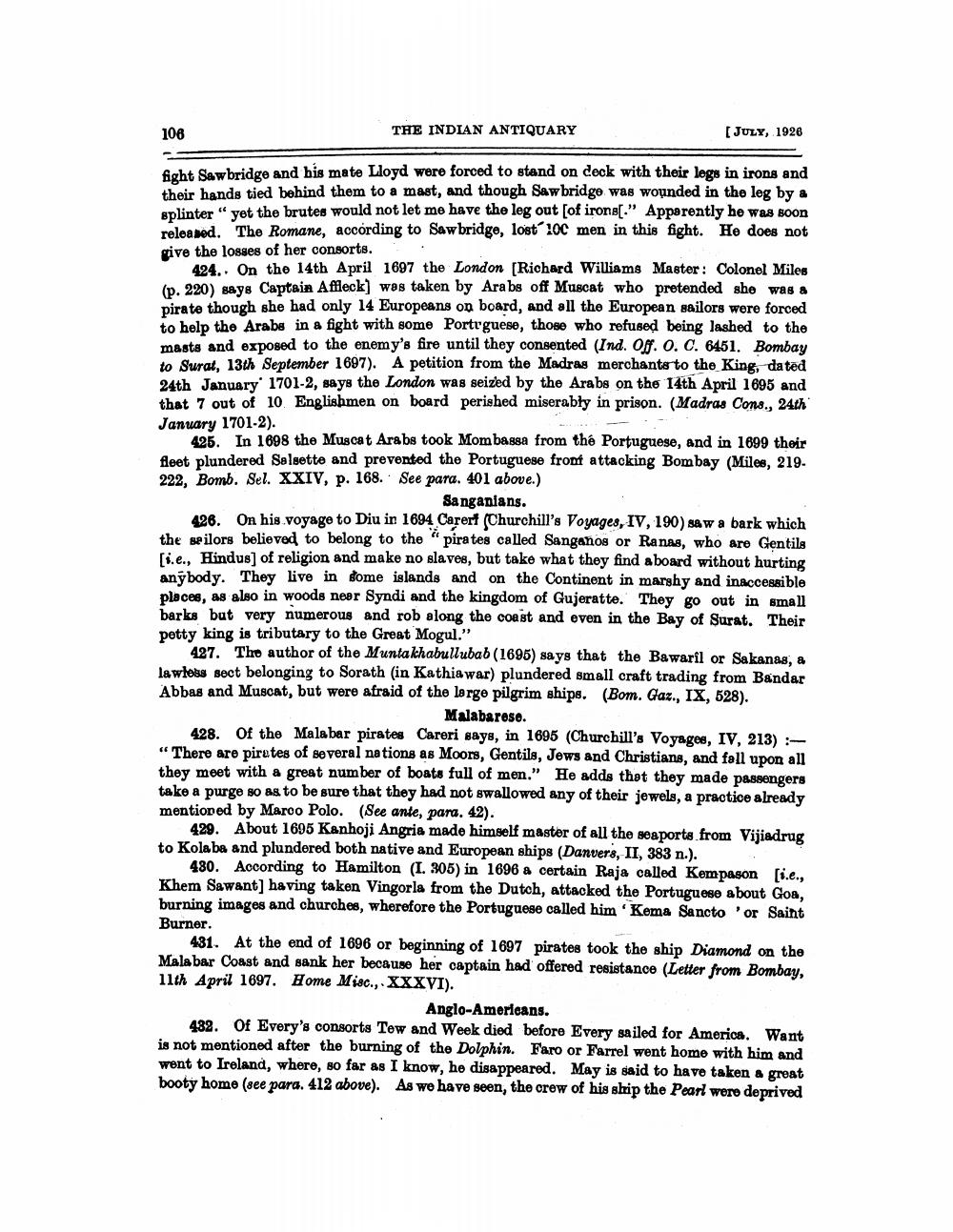________________
106
THE INDIAN ANTIQUARY
(JULY, 1926
fight Sawbridge and his mate Lloyd were forced to stand on deck with their legs in irons and their hands tied behind them to a mast, and though Sawbridge was wounded in the log by a splinter " yet the brutes would not let me have the leg out [of irons[." Apparently he was soon released. The Romane, according to Sawbridge, lost 100 men in this fight. He does not give the losses of her consorts. .
424.. On the 14th April 1697 the London (Richard Williams Master: Colonel Miles (v. 220) gaye Captain Affleck] was taken by Arabs off Muscat who pretended she was a pirate though she had only 14 Europeans on board, and all the European sailors were forced to help the Arabs in a fight with some Portrguese, those who refused being lashed to the masts and exposed to the enemy's fire until they consented (Ind. Off. 0. C. 6451. Bombay to Surat, 13th September 1697). A petition from the Madras merchants to the King, dated 24th January 1701-2, says the London was seized by the Arabs on the 14th April 1695 and that 7 out of 10 Englishmen on board perished miserably in prison. (Madras Cons., 24th January 1701-2).
425. In 1698 the Muscat Arabs took Mombassa from the Portuguese, and in 1699 their fleet plundered Solsette and prevented the Portuguese front attacking Bombay (Miles, 219. 222, Bomb. Sel. XXIV, p. 168. See para. 401 above.)
Sanganians. 426. On his voyage to Diu in 1694 Carert (Churchill's Voyages, IV, 190) saw a bark which the sailors believed to belong to the "pirates called Sanganog or Ranas, who are Gentils lie., Hindus) of religion and make no slaves, but take what they find aboard without hurting anybody. They live in some islands and on the Continent in marshy and inaccessible places, as also in woods neer Syndi and the kingdom of Gujeratte. They go out in small barks but very numerous and rob along the coast and even in the Bay of Surat. Their petty king is tributary to the Great Mogul."
427. The author of the Muntakhabullubab (1696) says that the Bawaril or Sakanas, & lawless sect belonging to Sorath (in Kathiawar) plundered small craft trading from Bandar Abbas and Muscat, but were afraid of the large pilgrim ships. (Bom. Gaz., IX, 528).
Malabareso. 428. Of the Malabar pirates Careri says, in 1695 (Churchill's Voyages, IV, 213) - “There are pirates of several nations as Moors, Gentils, Jews and Christians, and fall upon all they meet with a great number of boats full of men.” He adds thot they made passengers take a purge so as to be sure that they had not swallowed any of their jewels, a practice already mentioned by Marco Polo. (See ante, para. 42).
429. About 1695 Kanhoji Angria made himself master of all the seaports from Vijiadrug to Kolaba and plundered both native and European ships (Danvers, II, 383 n.).
480. According to Hamilton (I. 305) in 1696 a certain Raja called Kempason (s.e., Khem Sawant) having taken Vingorla from the Dutch, attacked the Portuguese about Goa, burning images and churches, wherefore the Portuguese called him 'Kema Sancto 'or Saint Burner.
431. At the end of 1696 or beginning of 1697 pirates took the ship Diamond on the Malabar Coast and sank her because her captain had offered resistance (Letter from Bombay, 11th April 1697. Home Misc., . XXXVI).
Anglo-Americans. 482. Of Every's consorts Tew and Week died before Every sailed for America. Want is not mentioned after the burning of the Dolphin. Faro or Farrel went home with him and went to Ireland, where, so far as I know, he disappeared. May is said to have taken a great booty home (see para. 412 above). As we have seen, the crew of his ship the Pearl were deprived




